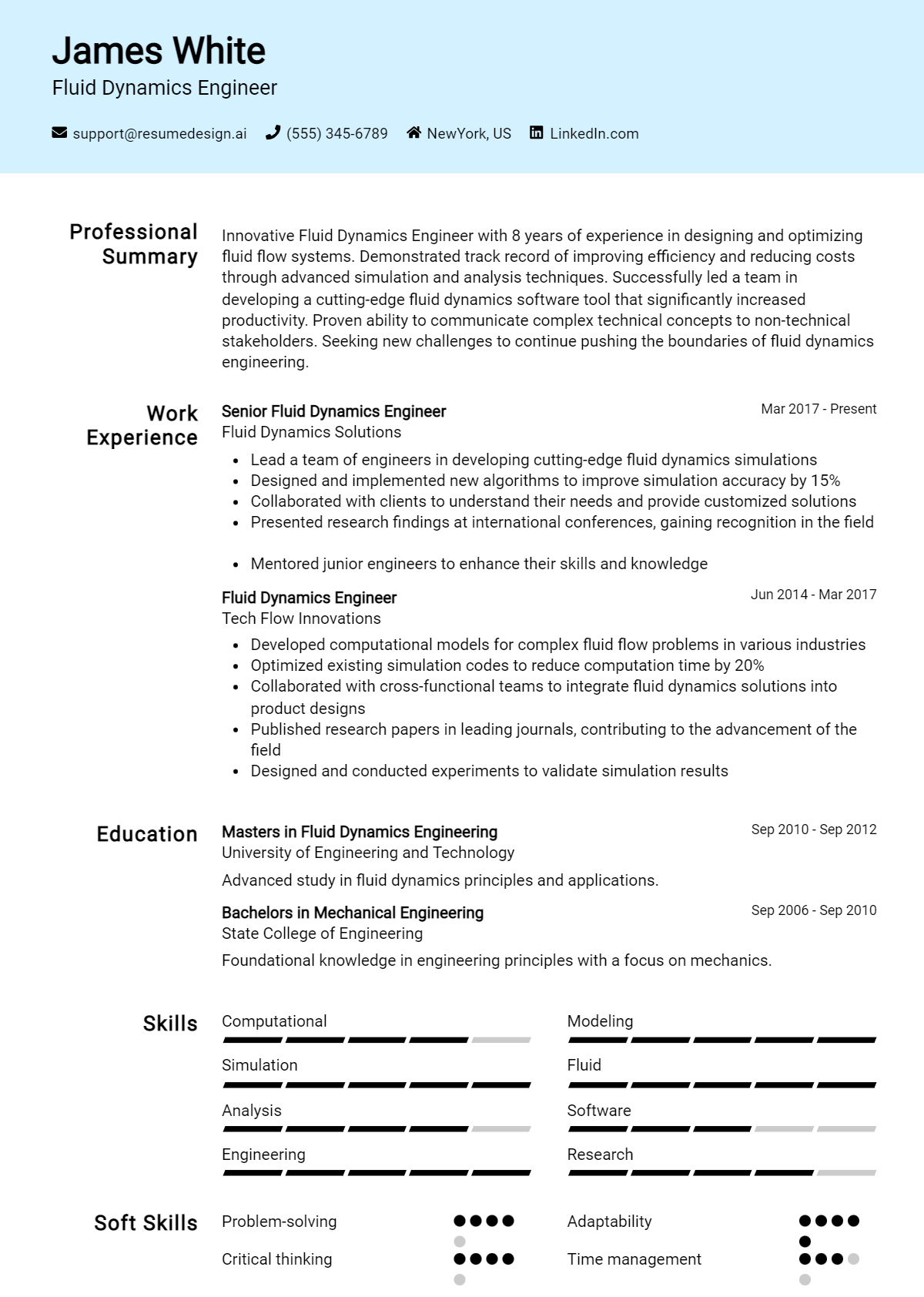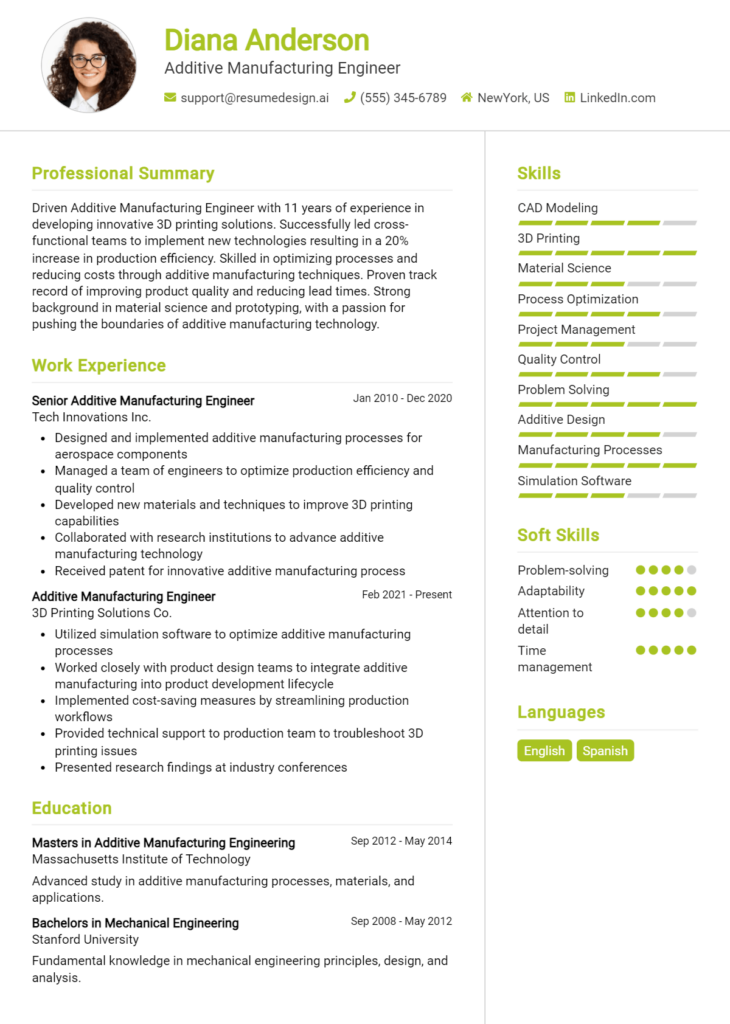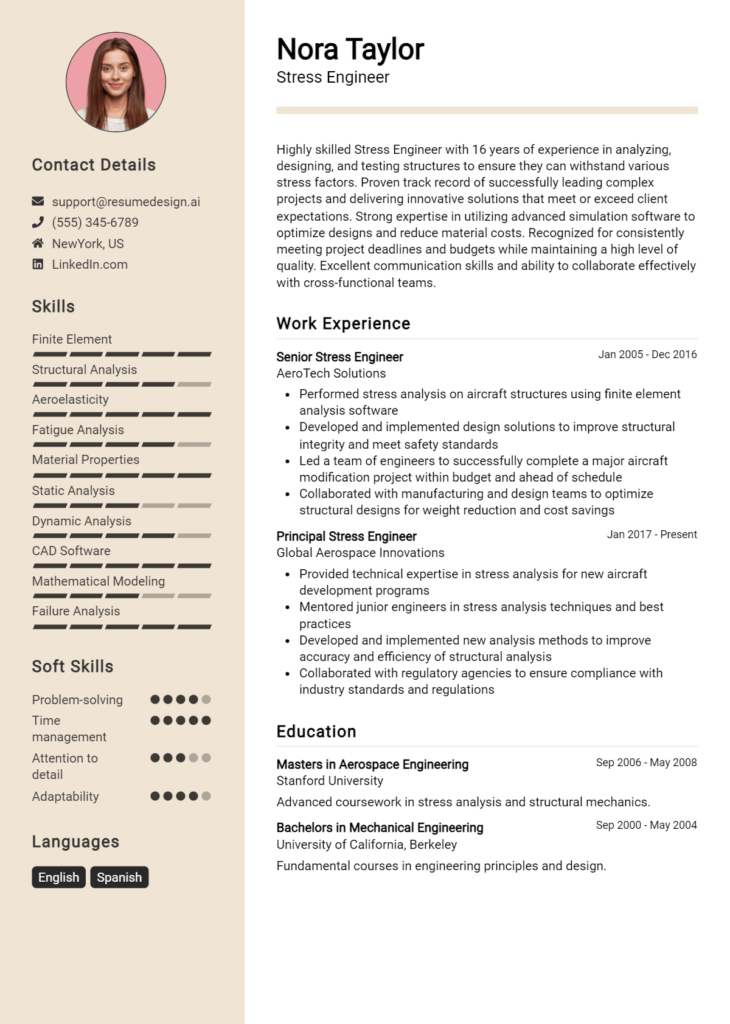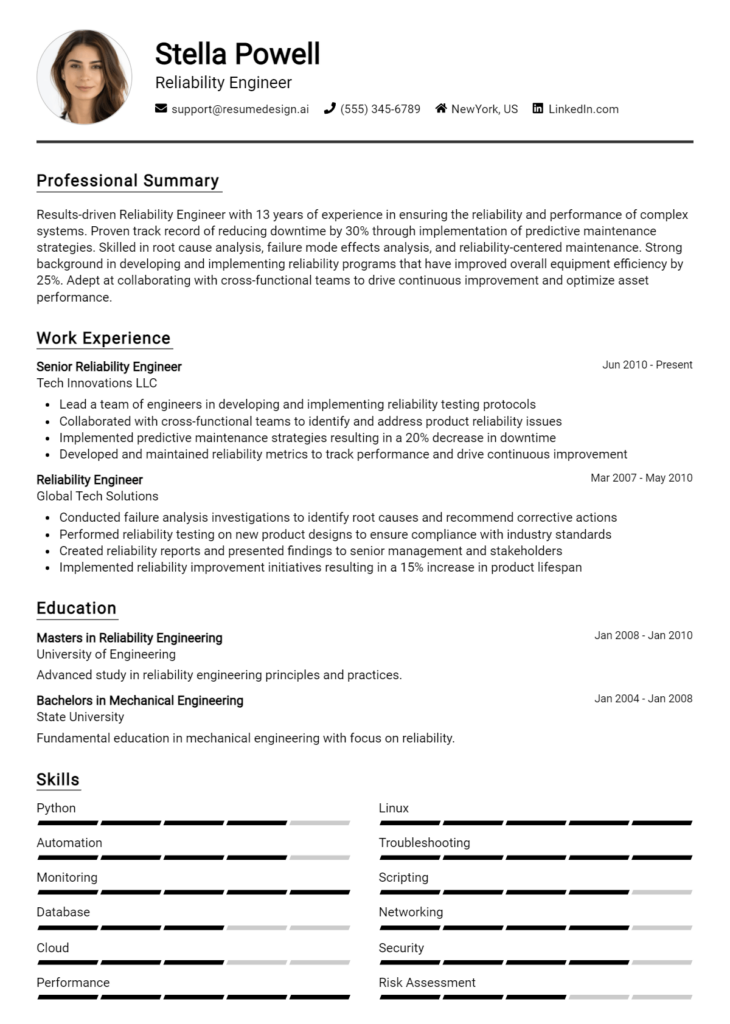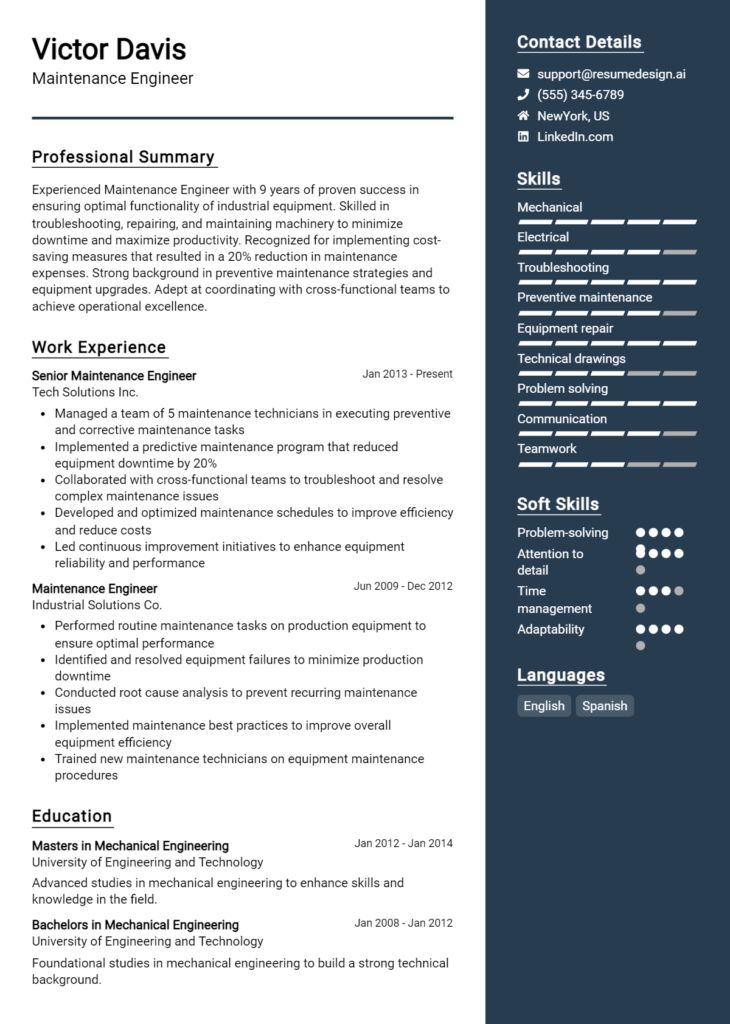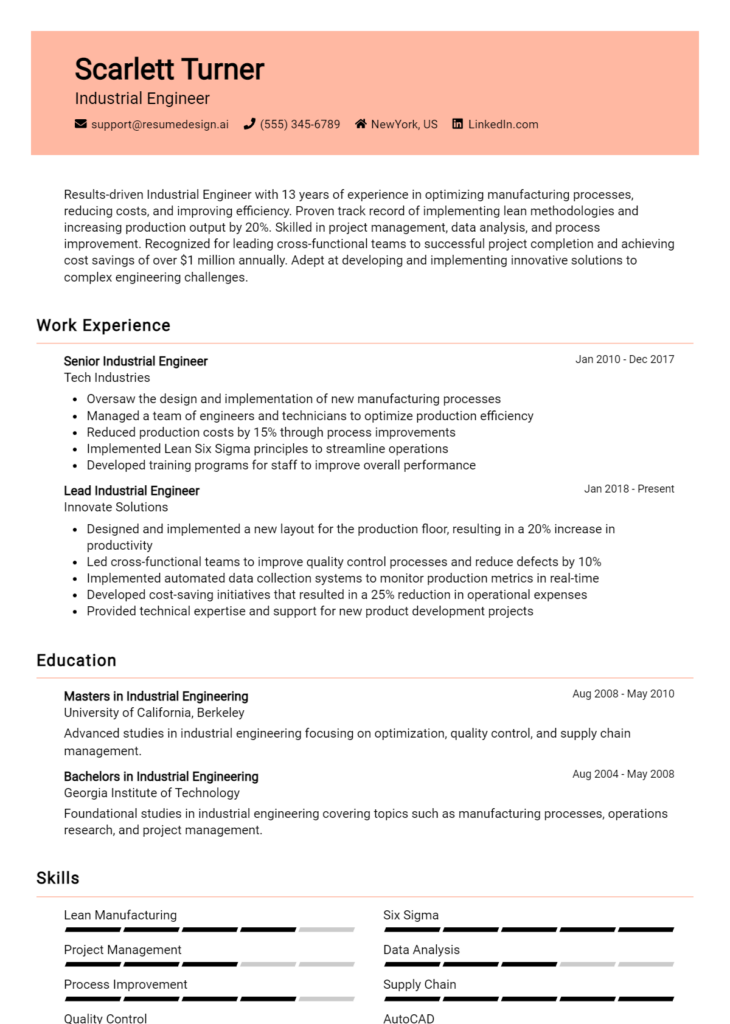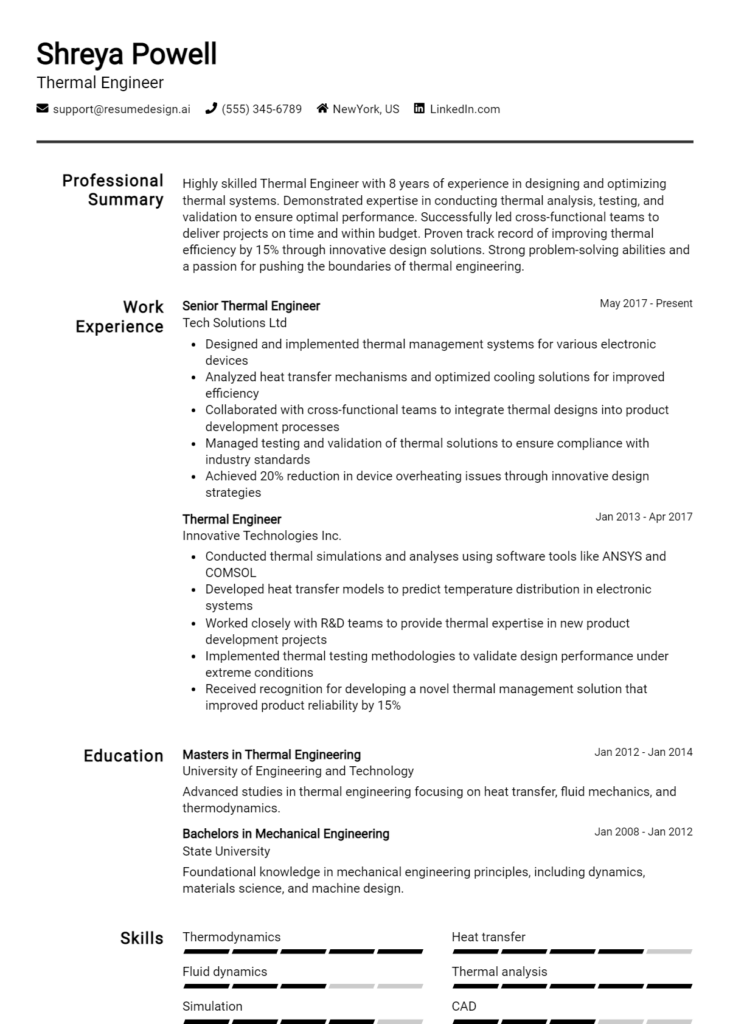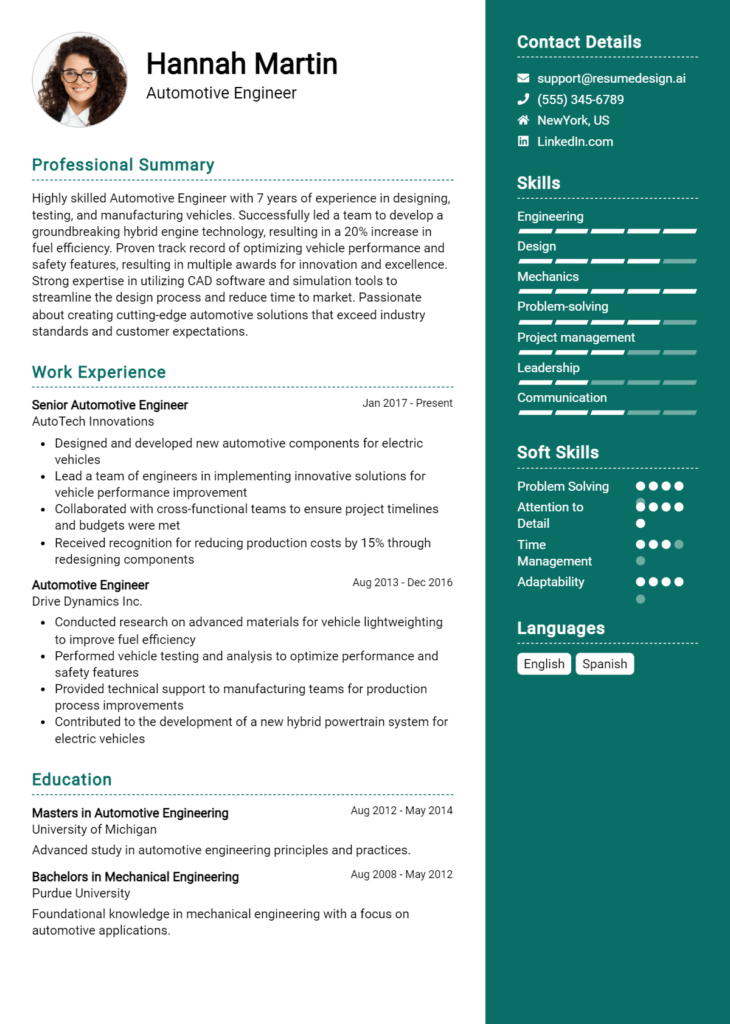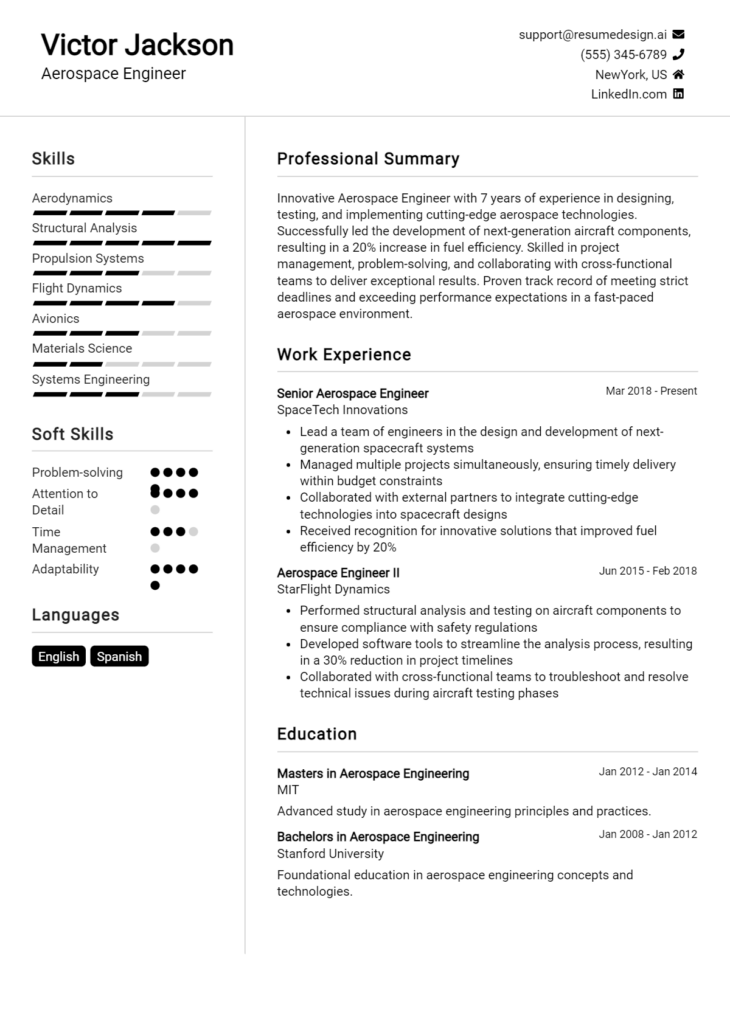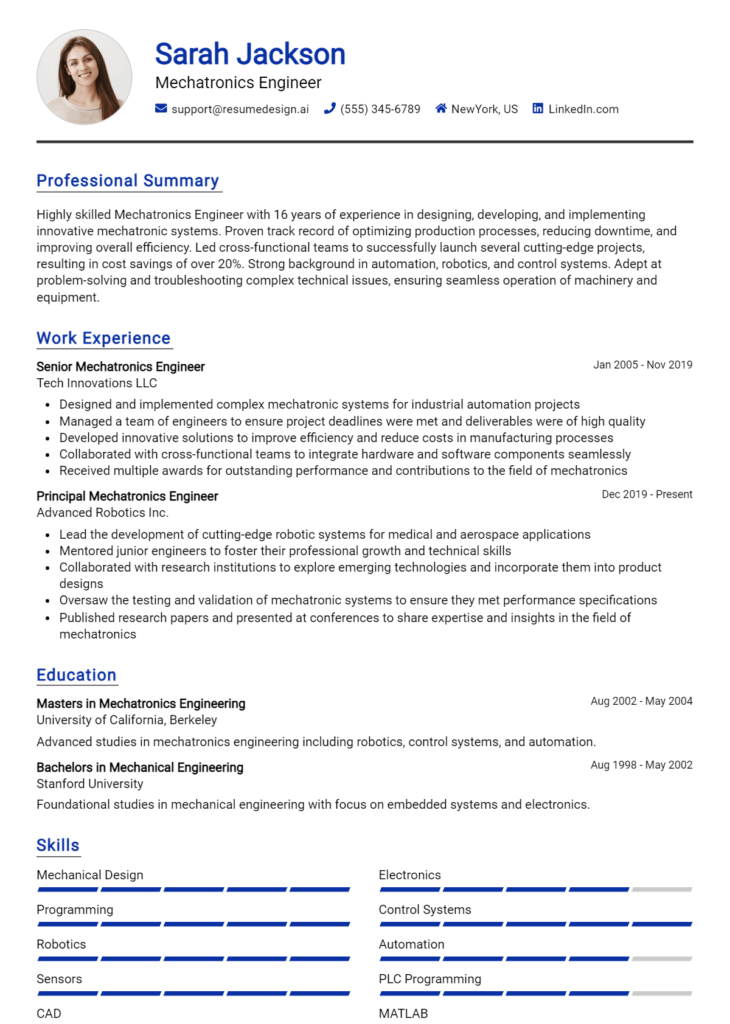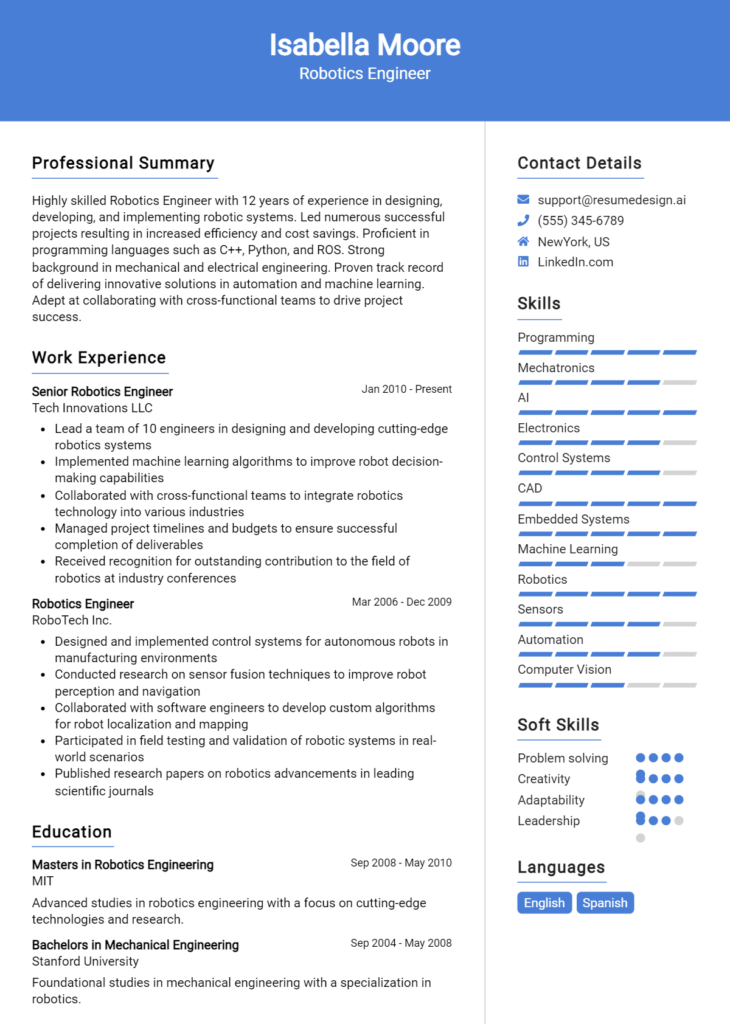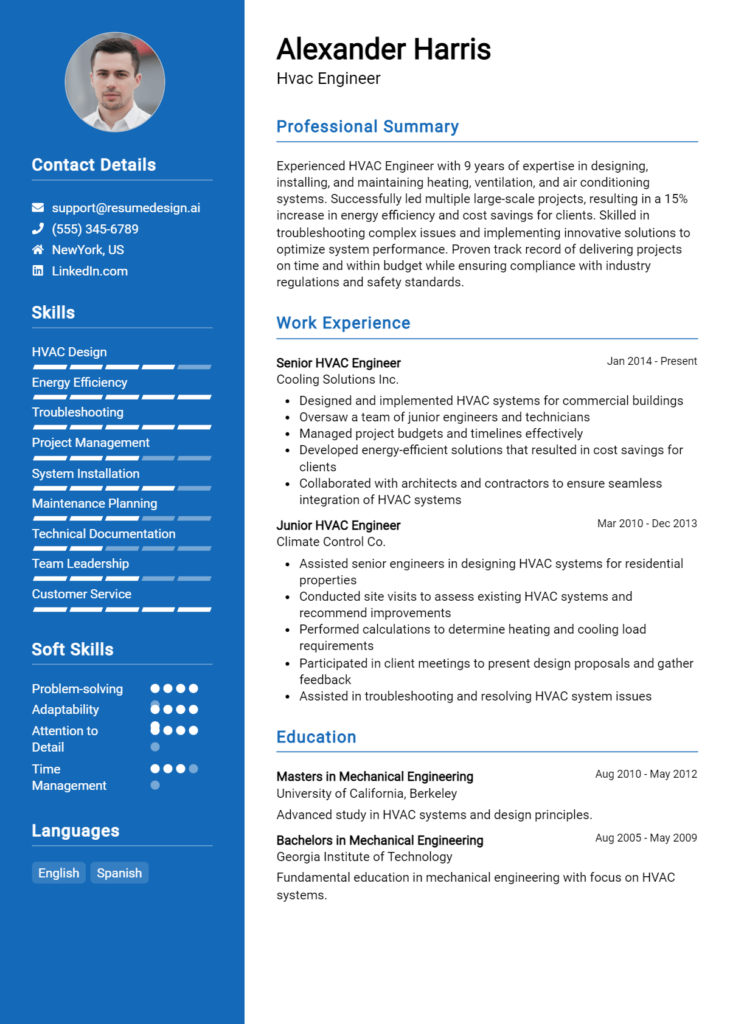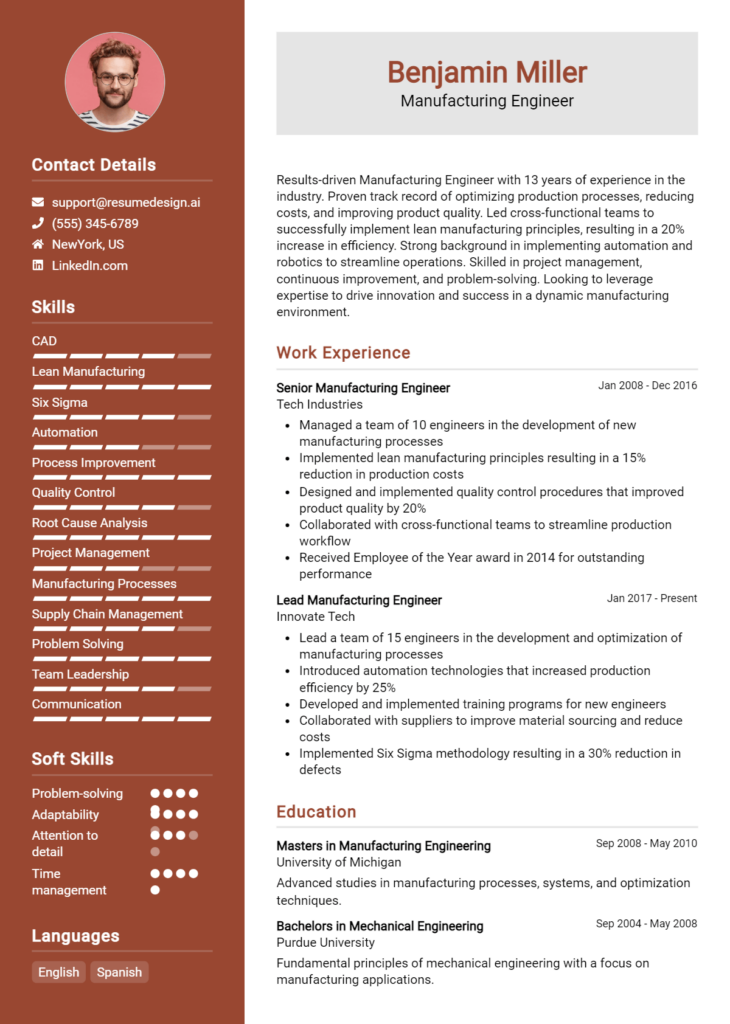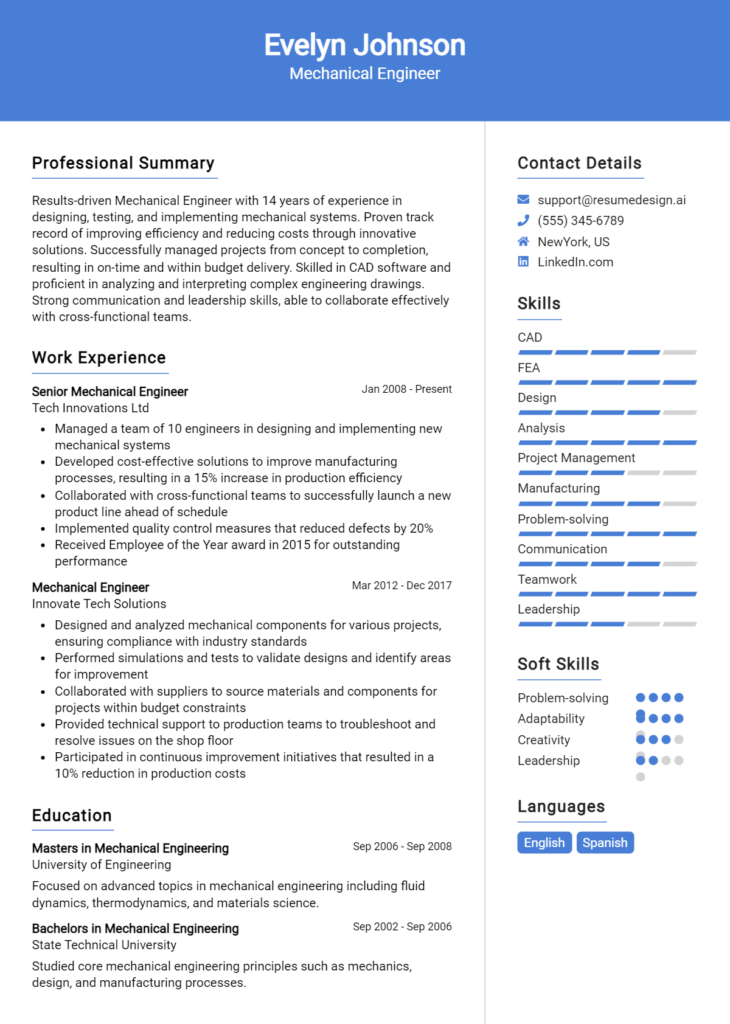Fluid Dynamics Engineer Core Responsibilities
A Fluid Dynamics Engineer plays a crucial role in analyzing and solving fluid flow problems across various industries, bridging departments such as design, manufacturing, and quality assurance. Key responsibilities include conducting simulations, optimizing designs, and collaborating with cross-functional teams to enhance product performance. Essential skills encompass advanced technical knowledge in fluid mechanics, operational efficiency, and strong problem-solving capabilities. These competencies are vital for achieving organizational goals, and a well-structured resume can effectively highlight these qualifications to potential employers.
Common Responsibilities Listed on Fluid Dynamics Engineer Resume
- Conduct computational fluid dynamics (CFD) simulations to analyze fluid behavior.
- Develop and optimize designs for fluid systems and components.
- Collaborate with multidisciplinary teams to integrate fluid dynamics into larger projects.
- Perform experiments and validate simulation results through testing.
- Analyze data to identify trends and propose engineering solutions.
- Prepare detailed technical reports and documentation.
- Stay updated on industry trends and advancements in fluid dynamics.
- Assist in the training and mentoring of junior engineers.
- Ensure compliance with safety and quality standards.
- Utilize software tools for modeling and analysis of fluid systems.
- Evaluate the performance of existing systems and recommend improvements.
- Participate in project planning and resource allocation.
High-Level Resume Tips for Fluid Dynamics Engineer Professionals
In the competitive field of fluid dynamics engineering, a well-crafted resume serves as a vital tool for making a strong first impression on potential employers. It is not just a summary of your career; it is a reflection of your skills, accomplishments, and unique qualifications that set you apart from other candidates. A thoughtfully designed resume can effectively showcase your technical expertise and project successes, enticing hiring managers to learn more about you. In this guide, we will provide practical and actionable resume tips specifically tailored for Fluid Dynamics Engineer professionals, ensuring your application stands out in a crowded job market.
Top Resume Tips for Fluid Dynamics Engineer Professionals
- Tailor your resume to the job description by using relevant keywords that match the specific skills and qualifications sought by the employer.
- Highlight your educational background, including any degrees or certifications in fluid dynamics, mechanical engineering, or related fields.
- Showcase relevant work experience, detailing your role in fluid dynamics projects, simulations, and analyses.
- Quantify your achievements by including metrics such as improved efficiencies, cost savings, or successful project completions.
- Emphasize technical skills such as proficiency in computational fluid dynamics (CFD) software, programming languages, and simulation tools.
- Include any industry-specific knowledge relevant to the position, such as experience with aerospace, automotive, or HVAC systems.
- Highlight any publications, presentations, or patents related to fluid dynamics that demonstrate your expertise and contributions to the field.
- Utilize action verbs to describe your responsibilities and accomplishments, creating a dynamic and engaging narrative of your professional journey.
- Keep your resume concise and focused, ideally one page, while ensuring it is visually appealing and easy to read.
By implementing these tips, you can significantly increase your chances of landing a job in the Fluid Dynamics Engineer field. A thoughtfully constructed resume that effectively highlights your skills, achievements, and relevant experiences can capture the attention of hiring managers and set the stage for further conversations about your potential contributions to their team.
Why Resume Headlines & Titles are Important for Fluid Dynamics Engineer
In the competitive field of fluid dynamics engineering, a well-crafted resume headline is vital for standing out among numerous applicants. A strong headline or title serves as an immediate hook that captures the attention of hiring managers, succinctly summarizing a candidate's key qualifications and expertise in just a few words. By being concise, relevant, and directly related to the job being applied for, the headline not only conveys professionalism but also highlights the candidate's suitability for the role. This initial impression can be the deciding factor in whether a resume gets a closer look or is set aside.
Best Practices for Crafting Resume Headlines for Fluid Dynamics Engineer
- Keep it concise: Aim for a headline that is short and to the point, ideally one sentence or phrase.
- Be role-specific: Tailor the headline to reflect the specific position you are applying for, highlighting relevant skills.
- Highlight key strengths: Focus on your most significant achievements, skills, or experiences that align with the job description.
- Use industry keywords: Incorporate keywords and phrases that are commonly used in fluid dynamics engineering to enhance visibility.
- Showcase your expertise: Emphasize your specialization or unique qualifications that set you apart from other candidates.
- Avoid jargon: Stay clear of overly technical terms that may not resonate with hiring managers outside of your field.
- Maintain professionalism: Ensure the tone is professional and reflects the seriousness of the engineering profession.
- Revise for clarity: Edit the headline multiple times to ensure it is clear and impactful, avoiding ambiguity.
Example Resume Headlines for Fluid Dynamics Engineer
Strong Resume Headlines
"Innovative Fluid Dynamics Engineer with 8 Years of Experience in Computational Fluid Dynamics (CFD)"
“Results-Driven Engineer Specializing in Aerodynamics and Thermodynamics Solutions”
“Expert in Fluid Mechanics with Proven Track Record in Reducing Drag Coefficients by 25%”
“Dynamic Fluid Dynamics Professional with Strong Background in Turbomachinery Design”
Weak Resume Headlines
“Engineer Looking for Opportunities”
“Fluid Dynamics Engineer”
“Experienced Professional”
Strong resume headlines effectively communicate a candidate's unique qualifications and align closely with the job requirements, making them memorable and compelling. They highlight specific skills and accomplishments, demonstrating the candidate's potential value to the employer. In contrast, weak headlines are often too vague or generic, failing to convey any real information about the candidate's expertise or relevance to the position, which can lead to missed opportunities in a competitive job market.
Writing an Exceptional Fluid Dynamics Engineer Resume Summary
A resume summary is a crucial component of a Fluid Dynamics Engineer's application, as it serves as the first impression to hiring managers. A strong summary succinctly showcases key skills, relevant experience, and notable accomplishments that align with the job role, quickly capturing the attention of recruiters. By distilling your qualifications into a concise and impactful statement, you can effectively highlight your expertise in fluid dynamics, computational fluid dynamics (CFD), and related technologies, making it easier for employers to recognize your fit for the position. Tailoring this summary to the specific job description not only demonstrates your attention to detail but also reinforces your genuine interest in the role.
Best Practices for Writing a Fluid Dynamics Engineer Resume Summary
- Quantify Achievements: Use specific numbers and metrics to demonstrate your contributions and successes.
- Focus on Relevant Skills: Highlight key technical skills, such as software proficiency in CFD tools, that are directly applicable to the job.
- Tailor for the Job Description: Customize your summary to reflect the requirements and responsibilities outlined in the job posting.
- Be Concise: Aim for 3-5 sentences that deliver your message without unnecessary fluff.
- Showcase Industry Knowledge: Include industry-specific terminology and trends to illustrate your expertise.
- Emphasize Problem-Solving Abilities: Highlight your capacity to tackle complex engineering challenges.
- Include Soft Skills: Mention key interpersonal skills, such as teamwork and communication, that enhance your technical abilities.
- Use Strong Action Verbs: Start sentences with dynamic verbs to convey a sense of proactivity and impact.
Example Fluid Dynamics Engineer Resume Summaries
Strong Resume Summaries
Results-driven Fluid Dynamics Engineer with over 5 years of experience in optimizing aerodynamic designs, successfully reducing drag by 15% on various aerospace projects. Proficient in ANSYS and OpenFOAM, with a strong background in computational fluid dynamics (CFD) simulations and data analysis.
Detail-oriented Fluid Dynamics Engineer with a proven track record of enhancing fluid flow efficiency in industrial applications, leading to a 20% increase in system performance. Expertise in experimental methods and numerical modeling, complemented by a Master's degree in Mechanical Engineering.
Innovative Fluid Dynamics Engineer specializing in heat transfer and fluid flow analysis, with 4+ years of experience in the automotive sector. Developed a cutting-edge cooling system that improved thermal efficiency by 25%, utilizing advanced simulation techniques.
Weak Resume Summaries
Experienced engineer with some knowledge of fluid dynamics. Looking to apply skills in a new role.
Fluid Dynamics Engineer interested in engineering opportunities. Has worked on various projects and enjoys solving problems.
The examples provided illustrate the stark contrast between strong and weak resume summaries. Strong summaries are characterized by their specificity, quantifiable achievements, and direct relevance to the role, making them compelling to hiring managers. In contrast, weak summaries lack detail, provide vague descriptions, and fail to demonstrate the candidate's unique value, which diminishes their impact in a competitive job market.
Work Experience Section for Fluid Dynamics Engineer Resume
The work experience section of a Fluid Dynamics Engineer resume is critical as it provides potential employers with insight into the candidate's technical skills and practical applications of fluid dynamics principles. This section highlights the engineer's ability to manage teams, collaborate effectively, and deliver high-quality products within the constraints of project timelines and budgets. By quantifying achievements and aligning past experiences with industry standards, candidates can demonstrate their value and readiness to contribute to future projects.
Best Practices for Fluid Dynamics Engineer Work Experience
- Highlight specific technical skills relevant to fluid dynamics, such as computational fluid dynamics (CFD) software proficiency.
- Quantify achievements with metrics, such as percentage improvements in efficiency or cost savings on projects.
- Emphasize leadership roles in projects, showcasing the ability to manage teams and mentor junior engineers.
- Detail collaboration with cross-functional teams to demonstrate effective communication and teamwork.
- Include relevant certifications or training that enhance technical expertise in fluid dynamics.
- Describe the impact of projects on the organization, linking outcomes to business objectives.
- Use action verbs to convey initiative and results-driven approaches in your work experiences.
- Tailor the work experience section to align with the specific requirements and expectations of the job description.
Example Work Experiences for Fluid Dynamics Engineer
Strong Experiences
- Led a team of 5 engineers in a project that optimized fluid flow systems, resulting in a 30% reduction in energy consumption across multiple facilities.
- Utilized advanced CFD simulations to redesign a key component of the cooling system, achieving a 25% increase in thermal efficiency.
- Collaborated with cross-disciplinary teams to develop an innovative prototype, which was recognized with an industry award for outstanding engineering design.
- Managed a budget of $500,000 for a fluid dynamics project, delivering results 10% under budget and ahead of schedule.
Weak Experiences
- Worked on fluid dynamics projects.
- Assisted in the development of engineering designs.
- Participated in team meetings regarding project progress.
- Involved in various tasks related to fluid systems.
The examples of strong experiences demonstrate clear, quantifiable outcomes and specific contributions that showcase leadership, technical expertise, and collaborative efforts. In contrast, the weak experiences lack detail and measurable results, making them less impactful and failing to convey the candidate's true capabilities and accomplishments in the field of fluid dynamics engineering.
Education and Certifications Section for Fluid Dynamics Engineer Resume
The education and certifications section of a Fluid Dynamics Engineer resume is crucial as it serves to highlight the candidate's academic foundation and commitment to professional development in a highly specialized field. This section not only showcases degrees from reputable institutions but also emphasizes any industry-relevant certifications and specialized training programs that the candidate has undertaken. By including pertinent coursework and continuous learning efforts, candidates can significantly enhance their credibility, demonstrating their alignment with the technical and theoretical demands of the role and their dedication to staying current with advancements in fluid dynamics.
Best Practices for Fluid Dynamics Engineer Education and Certifications
- List degrees in reverse chronological order, starting with the most recent.
- Include relevant coursework that directly applies to fluid dynamics and engineering principles.
- Highlight industry-recognized certifications, such as Certified Fluid Power Specialist (CFPS) or equivalent.
- Indicate any specialized training or workshops attended related to computational fluid dynamics (CFD) or other advanced topics.
- Provide the institution name, location, and graduation date for each degree or certification.
- Use concise bullet points to maintain clarity and readability.
- Tailor the content to match the specific job description and requirements.
- Consider including professional affiliations or memberships in relevant organizations.
Example Education and Certifications for Fluid Dynamics Engineer
Strong Examples
- M.S. in Mechanical Engineering, University of California, Berkeley, 2021
- Certified Fluid Power Specialist (CFPS), 2022
- Relevant Coursework: Advanced Fluid Dynamics, Computational Fluid Dynamics (CFD), Thermodynamics
- B.S. in Aerospace Engineering, Georgia Institute of Technology, 2019
Weak Examples
- Diploma in General Studies, Community College, 2018
- Certification in Basic Computer Skills, 2020
- B.A. in History, State University, 2017
- Online Course in Social Media Marketing, 2021
The strong examples are considered effective as they directly relate to the qualifications and skills necessary for a Fluid Dynamics Engineer, showcasing advanced degrees and relevant certifications that reflect both technical expertise and a commitment to the field. In contrast, the weak examples highlight educational backgrounds and certifications that lack relevance to fluid dynamics, potentially undermining the candidate's qualifications and alignment with the job role.
Top Skills & Keywords for Fluid Dynamics Engineer Resume
In the competitive field of fluid dynamics engineering, having a well-crafted resume that highlights the right skills is crucial for standing out to potential employers. A strong combination of hard and soft skills not only showcases your technical expertise but also demonstrates your ability to collaborate, communicate, and problem-solve effectively in a team environment. Employers are keen to see a balance of analytical capabilities and interpersonal skills, as these are essential for successful project execution and innovation in fluid dynamics. By strategically incorporating skills into your resume, you can effectively illustrate your qualifications and readiness for the challenges of this dynamic field.
Top Hard & Soft Skills for Fluid Dynamics Engineer
Soft Skills
- Problem-solving abilities
- Strong communication skills
- Team collaboration
- Critical thinking
- Attention to detail
- Adaptability
- Time management
- Creativity
- Leadership potential
- Interpersonal skills
Hard Skills
- Computational Fluid Dynamics (CFD)
- Fluid mechanics principles
- MATLAB proficiency
- AutoCAD and other design software
- Data analysis and statistical methods
- Experimental fluid dynamics techniques
- Multiphase flow analysis
- Heat transfer analysis
- Programming languages (e.g., Python, C++)
- Knowledge of relevant industry standards and regulations
By focusing on both soft and hard skills, you can create a comprehensive and appealing resume that not only highlights your technical capabilities but also reflects your potential to contribute to a collaborative workplace. Additionally, showcasing relevant work experience can further solidify your qualifications in the eyes of employers.
Stand Out with a Winning Fluid Dynamics Engineer Cover Letter
As a highly motivated and detail-oriented Fluid Dynamics Engineer with over five years of experience in computational fluid dynamics (CFD) and experimental analysis, I am excited to apply for the position at [Company Name]. My academic background in mechanical engineering, combined with my hands-on experience in fluid mechanics, has equipped me with a robust understanding of fluid behavior and its applications in various industries, including aerospace, automotive, and energy. I am eager to bring my expertise in simulation tools and fluid dynamics principles to your innovative team.
In my previous role at [Previous Company Name], I successfully led a project focused on optimizing the aerodynamic performance of a next-generation aircraft wing. Utilizing advanced CFD software, I was able to identify critical flow patterns and recommend design modifications that resulted in a 15% increase in lift-to-drag ratio. My strong analytical skills and ability to work collaboratively with multidisciplinary teams enabled us to achieve project milestones ahead of schedule, ultimately contributing to a successful product launch. I am confident that my technical acumen, combined with my proactive approach to problem-solving, would make me a valuable asset to your organization.
I am particularly impressed by [Company Name]'s commitment to innovation and excellence in fluid dynamics applications. I am drawn to your focus on sustainable engineering solutions and pioneering technologies that address the challenges of modern society. I am eager to contribute to ongoing projects and help advance your mission of creating efficient and environmentally friendly systems. My passion for fluid dynamics, along with my dedication to continuous learning and professional development, aligns perfectly with your company’s values.
I look forward to the opportunity to discuss how my background, skills, and enthusiasms align with the goals of [Company Name]. Thank you for considering my application. I am excited about the possibility of contributing to your team and helping drive the future of fluid dynamics engineering.
Common Mistakes to Avoid in a Fluid Dynamics Engineer Resume
When crafting a resume for a Fluid Dynamics Engineer position, it's essential to present your skills and experiences effectively. Many candidates make common mistakes that can hinder their chances of landing an interview. Avoiding these pitfalls can enhance the clarity and professionalism of your resume, showcasing your qualifications for this specialized role. Here are some frequent errors to steer clear of:
Lack of Relevant Keywords: Failing to include industry-specific keywords can result in your resume being overlooked by Applicant Tracking Systems (ATS). Incorporate terms like "computational fluid dynamics (CFD)," "turbulence modeling," and "finite element analysis" to align with job descriptions.
Vague Job Descriptions: Providing unclear or overly general descriptions of past roles can leave hiring managers unsure about your specific contributions. Use quantifiable achievements and detailed descriptions of your responsibilities to demonstrate your impact.
Ignoring Soft Skills: While technical expertise is crucial, neglecting to highlight soft skills such as teamwork, communication, and problem-solving can make your resume less compelling. Include examples of how you collaborated with multidisciplinary teams or led projects.
Poor Formatting: A cluttered or unprofessional layout can detract from your qualifications. Ensure your resume is well-organized, using consistent fonts, bullet points for clarity, and appropriate headings to guide the reader through your experience.
Omitting Certifications and Licenses: In the engineering field, relevant certifications (such as a Professional Engineer license) are vital. Failing to include these credentials can undermine your qualifications. List any certifications prominently in your resume.
Neglecting Continuous Learning: The field of fluid dynamics is constantly evolving. Not mentioning ongoing education, workshops, or relevant courses can suggest stagnation. Highlight any additional training or professional development that enhances your expertise.
Not Tailoring for Each Application: Using a generic resume for multiple applications can lead to missed opportunities. Customize your resume for each position by aligning your skills and experiences with the specific job requirements.
Typographical Errors: Simple mistakes in spelling or grammar can create an unprofessional impression. Always proofread your resume or have someone else review it to catch any errors before submission.
Conclusion
As a Fluid Dynamics Engineer, your expertise in analyzing and optimizing fluid flow is crucial in various industries, from aerospace to civil engineering. Throughout this article, we explored the essential skills and qualifications that employers seek, including proficiency in computational fluid dynamics (CFD), a strong foundation in mathematics and physics, and experience with simulation software. Understanding the principles of fluid mechanics and having hands-on experience with experimental methods can set you apart in this competitive field.
With the demand for skilled Fluid Dynamics Engineers on the rise, it's vital to ensure that your resume effectively showcases your skills and experiences. A well-crafted resume not only highlights your technical abilities but also demonstrates your problem-solving skills and innovative thinking in fluid dynamics applications.
Now is the perfect time to review your Fluid Dynamics Engineer resume. Consider utilizing resources such as resume templates, which can provide a professional layout to present your qualifications effectively. Additionally, a resume builder can streamline the process, allowing you to focus on your strengths and accomplishments. If you're looking for inspiration, explore resume examples tailored for engineering roles. Finally, don’t forget the importance of a compelling cover letter; check out our cover letter templates to help you make a strong first impression.
Take action today to refine your resume and position yourself for success in your Fluid Dynamics Engineering career!

